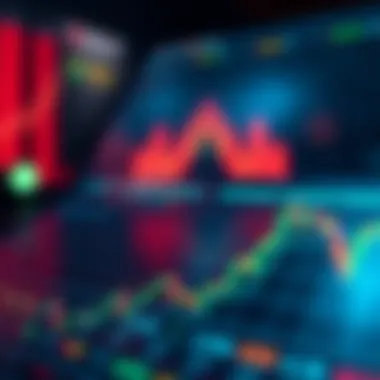Understanding Margin in Trading: A Comprehensive Exploration


Intro
Margin trading is a vital component of financial markets, pivotal for traders seeking to amplify their potential returns. However, it is essential to grasp not just its mechanics, but also the volatility it brings into play. Whether you're a seasoned investor or a newcomer in the world of trading, understanding margin and its implications helps in making educated decisions.
This discourse aims to unravel the layers surrounding margin trading, beginning with the forces that shape current market trends and guiding you into the broader landscape where these concepts play out. The ins and outs of margin accounts, risk management, and effective strategies will be highlighted, ensuring that you walk away equipped with the knowledge necessary to navigate this complex yet rewarding terrain.
Market Trends and Analysis
Current Market Overview
As of now, the trading atmosphere fluctuates like a leaf in the wind. Recent market shifts are characterized by a growing interest in cryptocurrencies and emerging sectors. Margin trading, in particular, has captured the attention of many, as it provides the opportunity to leverage one's capital.
The DOM (Depth of Market) is illustrative of this shift. With different assets having varying liquidity levels, traders must keep an eye on market sentiment and external factors influencing prices. Economic indicators, such as interest rates and inflation figures, can sway trading volumes significantly.
Key Indicators and Metrics
Understanding the crux of margin trading requires an awareness of essential metrics:
- Margin Ratio: This quantifies how much of your equity is used to support your unseen ownership in trades.
- Leverage: Often indicated as a ratio, leverage highlights how much control over assets a trader can command with minimal capital. For example, a 10:1 leverage means that for every $1 a trader has, they can control $10 worth of securities.
- Margin Call: An important red flag. This is triggered when your account value drops below the required maintenance margin. Losing ground here signifies the necessity for immediate action to restore your position.
Traders should be acutely aware of these indicators when employing margin to ensure they don't find themselves in the deep end without a paddle.
"Leverage can be a double-edged sword; use it wisely or risk a swift downturn."
Investment Strategies
Investors often toggle between short-term and long-term strategies, both vital but qualitatively different.
Long-term vs Short-term Strategies
- Long-term Strategies: These often involve buying and holding securities, banking on price appreciation over time. A margin account can amplify potential returns, yet it also increases exposure to risk.
- Short-term Strategies: These engage in more speculative trades, capitalizing on immediate price alterations. Margin can play an explosive role here, enabling traders to take larger positions, but with greater vulnerability to market swings.
Risk Management Techniques
Risk is the name of the game in trading. Employing effective risk management techniques is a must:
- Stop-Loss Orders: Automatically trigger a sale when prices reach a certain threshold, minimizing losses.
- Diversification: Splitting investments across various assets helps to mitigate risk.
- Regular Monitoring: Keeping abreast with market trends and news can provide insights to adjust strategies as needed.
Each of these strategies should be tailored to align with the trader’s individual risk tolerance, trading goals, and overall market conditions.
As we venture deeper into the mechanics of margin accounts and the regulatory framework that dictates their use, it's crucial to maintain an inquisitive mindset and not shy away from asking questions. The world of margin is intricate and may at times seem daunting, yet with the right approach and understanding, it can lead to rewarding opportunities.
Preamble to Margin Trading
Margin trading, while a powerful tool for many in the financial world, often walks hand-in-hand with complexity and risk. It opens a window to new opportunities, allowing traders to leverage investments greater than their actual capital. This aspect of trading isn't just about investing more but also about understanding what margin truly signifies in the context of financial markets.
In this article, we will illuminate the various facets of margin trading, breaking down its intricacies so that even those relatively new to trading can grasp the foundational concepts and more seasoned traders can refine their understanding. The fluidity of markets today amplifies the need to be well-versed in how margin works, the potential benefits it offers, and the careful considerations that come with its use.
Margin can define the difference between taking a calculated risk and being swept away in the storm of fluctuating prices. Understanding its mechanism allows traders—from novice investors to expert analysts—to navigate the turbulent waters of trading with more confidence. It's about weighing the risks against the rewards, as margin increases both in potential profit and the possibility of significant loss. Thus, this introduction lays the groundwork for the discussions on how margin applies today, its historical underpinnings, and the mechanisms of its application.
Defining Margin in the Trading Context
At its core, margin refers to the collateral that an investor must deposit with a broker to cover potential losses when trading financial instruments like stocks, futures, or forex. This isn’t just a buffer; it's a lifeline that allows traders to engage in transactions larger than their available cash. For instance, if you maintain a margin account, you might find yourself able to trade with double or even triple the amount of your actual capital, elevating both risk and potential reward.
The type of margin often discussed in trading includes initial margin, which is the percentage of the investment that must be funded by the trader when the position is opened, and maintenance margin, which is the minimum account balance to keep the position active. It’s crucial to grasp these terms as they serve as the heartbeat of margin trading protocols.
Historical Perspectives on Margin Trading


Margin trading isn’t a new concept. Its origins can be traced back centuries in various forms and markets. In the early days of stock trading, investors would often borrow money to purchase numerous shares, intending to pay off the loan with profits generated from these trades. This practice, however, wasn't without its pitfalls, leading to a number of economic crises as margins were leveraged too aggressively.
A famous example includes the stock market crash of 1929, where many investors had bought stocks on margin, and when prices fell, they faced margin calls resulting in widespread financial ruin. Such calamities have shaped the regulations we see today and continue to influence trading practices. Understanding this history is vital, as it highlights the volatility that margin trading can introduce into markets and informs the regulatory landscapes that govern it today. By examining these historical perspectives, traders gain insights not only into the risks involved but also into the necessity for sound risk management practices in margin trading.
How Margin Works
Understanding how margin works is crucial for anyone involved in trading, be it seasoned investors or novices. Margin allows traders to extend their purchasing power by borrowing funds from a broker. This leveraging, while potentially increasing profits, carries its own set of risks. Proper knowledge of margin mechanics, requirements, and how margin calls function can greatly influence trading success.
Mechanics of Margin Transactions
Margin transactions involve a specific process where a trader uses borrowed money to trade larger positions than they can afford with their own capital alone. Here’s how it typically unfolds:
- Opening a Margin Account: To trade on margin, you must first open a margin account with a broker. This account is different from a regular trading account because it allows for borrowing.
- Borrowing Funds: The broker lends you a portion of the funds needed to execute a larger trade. For example, if you want to buy $10,000 worth of stocks, and the broker allows a 50% margin requirement, you would need only $5,000 of your own capital.
- Leverage: Margin provides leverage, which means your potential returns can be amplified. However, this works the other way around, amplifying potential losses too. A small move in a stock price could lead to a substantial loss or gain.
- Interest Charges: It’s important to keep in mind that borrowing doesn't come free. The broker will typically charge interest on the amount borrowed, adding another layer to the cost structure of trading on margin.
Understanding these elements can help traders make informed decisions about when and how to utilize margin effectively without overexposing themselves.
Initial and Maintenance Margin Requirements
Margin trading is governed by both initial and maintenance margin requirements, which represent the minimum equity you must maintain in your margin account.
- Initial Margin Requirement: This is the percentage of the purchase price that you need to pay from your own funds when you initiate a margin transaction. For example, if you're buying securities worth $20,000 and the broker's initial margin requirement is 60%, you'll need to bring in $12,000 before your broker lends you the remaining $8,000.
- Maintenance Margin Requirement: After you purchase securities, the maintenance margin is the minimum equity you must maintain in your margin account to keep your positions open. If the value of your account falls below this level, your broker may issue a margin call. This ratio is typically lower than the initial margin to allow traders some breathing room. If this requirement is not met, it could lead to forced liquidation of your assets to cover losses.
This structure places a significant responsibility on traders to monitor their accounts vigilantly and manage their equity carefully, especially in volatile markets.
Margin Call Explained
A margin call occurs when the equity in your margin account drops below the maintenance margin requirement. This is one of the more crucial concepts to grasp when trading on margin.
When your equity falls short, brokers will notify you to either deposit more funds or sell off some holdings to restore the required balance. Here’s how you can typically expect a margin call to unfold:
- Notification: The broker will usually inform you through phone or email. Ignoring this alert can lead to serious consequences.
- Action Required: You will need to quickly decide how to respond. This might mean sending additional funds or liquidating some of your positions. Delaying this can lead to automatic liquidation by the broker to cover the margin deficiency.
A margin call can be a wake-up call, reminding traders of the fine line between leverage and risk. Keeping a close watch on your margin levels is essential.
In essence, understanding margin calls is integral to risk management in trading. Investing time to understand each aspect of margin not only contributes to more informed decision-making processes but also helps in delineating when to proceed with caution in one's trading activities.
Types of Margin Accounts
In the realm of trading, particularly when one ventures into leveraging funds, understanding the various types of margin accounts is essential. These accounts serve different purposes and are tailored to the needs of distinct investors or traders. It's vital to grasp the nuances between them to make informed decisions when executing trades. Each type of margin account offers unique benefits and challenges, which can significantly affect trading strategies and risk profiles.
Standard Margin Account
A Standard Margin Account is the most common type of margin account utilized by investors. Here, traders can borrow funds from their brokerage to buy more securities than they could with just their cash balance. The typical requirement is that a trader must have at least 50% of the total purchase price of the securities in cash for an initial transaction.
Benefits of Standard Margin Accounts:
- Leverage: Traders can control larger positions without tying up more capital. This might amplify potential gains when the market is favorable.
- Flexibility: With borrowing available, traders can capitalize on market opportunities quickly without needing to sell other holdings to raise funds.
- Short Selling: This type of account allows for short selling, enabling traders to profit from declining stock prices.
Considerations:
While the advantages are enticing, it comes with risks, such as the potential for margin calls if the account value falls below a certain threshold. This can lead to forced liquidation of assets, compelling the trader to sell even in a downturn, which often leads to losses.
Margin Accounts for Cryptocurrency Trading
As cryptocurrency trades become more mainstream, specific margin accounts tailored for this kind of trading have emerged. Margin Accounts for Cryptocurrency Trading allow users to borrow funds from exchanges to buy various cryptocurrencies, maximizing their investment potential. Given the volatile nature of the crypto market, this can lead to substantial gains, but also sizeable losses.
Benefits:
- High Leverage: Many crypto exchanges offer high leverage, which can lead to significant profits from smaller price movements. For example, a 5x leverage allows a trader to control a position five times their actual capital.
- Diverse Options: Margin accounts for crypto often encompass a wide selection of cryptocurrencies, facilitating trading in diverse markets.
- Enhanced Trading Strategies: Traders can employ various strategies, including arbitrage and hedging, capitalizing on market inefficiencies.


However, it's crucial to note the risks associated with crypto margin trading. High volatility can create swift and substantial losses, and if one is not careful, it may lead to rapid account depletion.
Cash Account vs. Margin Account
Understanding the difference between a Cash Account and a Margin Account is fundamental for traders. In a cash account, funds must be available before executing any trades; it represents a more straightforward way of investing without borrowing. Conversely, a margin account allows a trader to leverage borrowed funds from the brokerage.
Key Distinctions:
- Funding Requirement: A cash account demands the entirety of the funds upfront for each trade, while margin accounts allow for partial funding through borrowing.
- Risk Exposure: Cash accounts inherently have lower risk since they limit the potential for significant losses from leveraged positions.
- Market Access: Margin accounts offer additional functionalities, such as short selling and immediate order execution without requiring full capital upfront.
Here’s a quick comparison:
| Feature | Cash Account | Margin Account | | Funding Requirement | Full funds upfront | Partial funds, borrowing allowed | | Risk Level | Lower risk | Higher risk | | Market Access | Limited to purchased | Includes short selling |
Each account type aligns with varying investment strategies and personal risk tolerance. Choosing an appropriate account can set the tone for one's trading experience, impacting profit potential and overall strategy.
"Understanding the distinctions between account types can not only safeguard your investments but can also maximize your trading opportunities."
For further insights on margin trading and its peculiarities, you may explore additional resources like Investopedia, NerdWallet, or CoinDesk, which offer in-depth analyses and discussions of these concepts.
Risks and Challenges of Margin Trading
Margin trading, while offering an enticing avenue for increased gains, is not without its pitfalls. Grasping the risks involved is crucial for any trader seeking to leverage margin for potential profits. In this section, we'll dive into the nuances of these risks, illuminate the challenges that come with margin trading, and arm you with essential insights to navigate the treacherous waters.
Potential for Amplified Losses
The most glaring risk tied to margin trading is the potential for amplified losses. Traders often approach margin with the mindset that their gains will multiply; however, they might overlook the flip side. When one trades on margin, they’re effectively borrowing funds, which means their potential losses are equally magnified.
For instance, if a trader invests $10,000 on a margin of 2:1, this allows them to control $20,000 worth of assets. A rise of just 10% in this scenario translates to a profit of $2,000. Conversely, however, a decline of 10% would mean losing $2,000—a 20% loss relative to their initial investment. In simple terms, one can quickly find themselves in a situation where they are not only losing their own capital but also owe additional funds to the brokerage. It’s a fine line between gaining and losing, and having a clear strategy is imperative to avoid riding the waves of poor price movements.
Market Volatility and Margin Risk
Equally critical to consider is the effect of market volatility on margin trading. Markets can be as unpredictable as a roll of the dice. Price swings can happen without a moment’s notice, catching even experienced traders off-guard. When the market experiences sharp fluctuations, margin accounts become vulnerable. Conditions such as geopolitical events, economic reports, or sudden shifts in investor sentiment can cause rapid changes in asset prices.
When volatility spikes, so does the chance of a margin call, which refers to the demand by the broker for additional funds in order to maintain an open position. Traders who are unable to satisfy this requirement may have their positions liquidated, potentially realizing significant losses. This could lead not only to losing one's investment but also to owing more than initially deposited.
The unpredictable nature of the market means that traders must keep a keen eye on economic indicators and world events. Here are some key points that a trader should keep in mind regarding market volatility and its impact on margin trading:
- Stay Informed: Keeping up with news and analytical assessments can provide a heads-up about potential market-moving events.
- Risk Assessment: Regular evaluations of market conditions and how they might impact your positions helps one stay proactive.
- Diversification: Avoid putting all your eggs in one basket. Spreading out your investments can mitigate risks associated with sudden price swings.
Always remember that margin trading should come with a healthy dose of caution. Trading on borrowed money should only be done after thorough analysis and self-reflection on risk tolerance.
In summary, while margin trading can significantly amplify profits, the associated risks, especially the potential for greater losses and the impact of volatility, warrant comprehensive consideration. Armed with this knowledge, traders can better prepare themselves to face the inherent challenges that margin trading entails. One must tread lightly; the higher the stakes, the deeper the pitfalls.
For further reading on the risks of margin trading, you may refer to resources on Securities and Exchange Commission and Investopedia's section on margin trading risks.
Strategies for Effective Margin Trading
Effective margin trading is not just about leveraging your capital. Instead, it encompasses a battery of strategies that can help mitigate risks and potentially enhance returns. Given the volatile nature of markets, the right approach can mean the difference between flourishing and floundering. Therefore, as we dive into strategies to sharpen your margin trading skills, it’s vital to understand their importance and nuances.
Developing a Risk Management Plan
When trading on margin, having a robust risk management plan is crucial. A well-structured plan enables traders to outline potential losses and, more importantly, define their limits. Specifically, risk management allows you to decide how much you're willing to risk on a particular trade. This should not merely include setting a stop-loss but also comprehensively considering your overall portfolio.
- Identify Risk Tolerance: Understand how much risk you can handle psychologically and financially. This might vary from one trader to another.
- Position Sizing: Determine how large each trade will be in relation to your total account balance. Many traders adhere to the '1% rule,' which suggests risking no more than 1% of your total capital on a single trade.
- Continuous Assessment: Regularly reassess your risk management plan as market conditions change. Flexibility is key in the fast-paced trading environment.
Crafting a risk management plan is akin to drawing up a blueprint for a house. It defines your limits and keeps your trading activities within the bounds of reasonableness.
Utilizing Stop-Loss Orders


A quintessential tool in the arsenal of a margin trader is the stop-loss order. This tool helps traders gather their thoughts when the market throws a curveball. By automatic selling of a security when it hits a predetermined price, stop-loss orders can protect you from unmanageable losses.
- Types of Stop-Loss Orders: There are several varieties, including fixed stop-loss orders, where you set a specific price, or trailing stop-loss orders, which adjust based on the price movement of the security. Choosing the right type depends on your trading strategy and market conditions.
- Placement Considerations: Placing your stop-loss order too close to your entry point may result in premature selling during standard volatility. On the flip side, placing it too far away might lead to bigger losses than intended. Understanding market trends and volatility can help in making a sound decision.
Stop-loss orders act as a safeguard against emotional decision-making, almost like a safety net during a tightrope walk. Ensuring you use these effectively could mean preserving not only your capital but your trading resolve.
Monitoring Market Conditions
Keeping a vigilant eye on market conditions is non-negotiable for anyone daring to take on margin trading. The financial seas are often turbulent and being informed allows you to make timely decisions.
- Utilize Technical Analysis: Familiarize yourself with indicators that can signal potential price movements. Charts, moving averages, and patterns can provide insights into market trends.
- Stay Updated on News Events: Economic data releases, company earnings, and geopolitical events can affect market sentiments. Subscribing to financial news sources or utilizing trading platforms with news feeds can help keep you in the loop.
- Adjust Your Strategy Accordingly: Markets can be fickle, so being adaptable is crucial. If conditions indicate increased volatility, you may choose to alter your trading strategy or even step back temporarily until the waves calm down.
In summary, the backbone of successful margin trading lies in establishing a solid strategy that encompasses risk management, disciplined use of stop-loss orders, and the keen monitoring of market conditions. Depending on these elements, a trader can effectively leverage their positions and navigate the unpredictable waters of trading with a level head and informed approach.
"Good trading isn’t about being right or wrong; it’s about how much you make when you’re right and how much you lose when you’re wrong." – George Soros
For further reading on trading strategies, consider visiting resources like Investopedia or Wikipedia to deepen your understanding of the intricate world of margins.
Regulatory Framework Surrounding Margin Trading
Understanding the regulatory framework for margin trading is essential for any participant in the financial markets. Proper regulations help maintain orderly markets, protect investors, and mitigate systemic risks. Furthermore, these regulations often set the parameters within which margin trading operates. This section will explore the role of regulatory bodies, the specific regulations established by bodies such as the Securities and Exchange Commission, and how these influence trader behavior and market stability.
Securities Exchange Commission Regulations
The Securities and Exchange Commission (SEC) plays a critical role in overseeing margin trading practices in the United States. Their regulations govern how firms can extend credit and enforce margin requirements, focusing on protecting investors from the excessive risk inherent in borrowing to finance trades. These requirements dictate the amount of equity a trader must maintain in a margin account.
Under SEC rules, brokerage firms are required to provide their clients with a clear outline of margin agreements. This clarity helps ensure that traders understand the risks involved before diving into margin trading.
- Key Regulations include:
- Regulation T: This regulation sets the initial margin requirement for purchasing securities on credit. Currently, it requires a minimum of 50% of the purchase price to be deposited.
- Regulation X: This addresses the extension of credit by lenders to consumers, ensuring that margin lending is conducted in good faith.
- Maintenance Margin Requirements: These are typically set at 25% of the total market value of the securities in the account. If the value drops below this threshold, a margin call is issued, requiring the trader to add funds or sell assets.
Understanding these regulations is crucial, as non-compliance can lead to significant penalties, including fines or even suspension of trading activities.
Impact of Regulatory Changes on Margin Trading
Regulatory changes can significantly impact margin trading. As markets evolve, so too do the risks associated with margin trading. When regulatory bodies adjust rules, they often tailor these changes in response to market conditions and incidents that may expose traders to undue risk.
For instance, after the 2008 financial crisis, regulations surrounding margin trading tightened considerably. This tightening was aimed at preventing future market collapses fueled by excessive leverage. As a result, traders have had to adapt their strategies and risk profiles in light of these new rules.
Some significant impacts include:
- Altered Trading Strategies: Traders may resort to less aggressive strategies or shift to less leveraged products to comply with regulations.
- Market Access and Liquidity: Stricter regulations can also affect how easily traders can enter and exit positions, potentially leading to lower market liquidity.
- Increased Compliance Costs: Brokerage firms often pass down the costs of compliance to their clients, affecting overall trading profitability.
"Regulatory measures serve as a double-edged sword, ensuring stability while also constraining traders’ options in dynamic markets."
By preparing adequately and understanding these frameworks, traders can navigate the complexities of margin more effectively, leading to better-informed trading decisions.
End and Future Considerations
The realm of margin trading presents an intersection of opportunity and risk that every trader must navigate with precision and foresight. The importance of understanding margin cannot be overstated, particularly in an era that continuously sees market volatility and rapid technological evolution. This concluding section encapsulates the insights gleaned from the discussion while highlighting the crucial takeaways and contemplating what lies ahead in the evolving landscape of margin trading.
Summary of Margin Trading Insights
As we reflect on the topics covered, several key insights emerge about margin trading.
- Leverage: Margin trading allows traders to amplify their buying power, enabling them to control larger positions with a smaller amount of capital. This can lead to significant profits but, conversely, magnified losses.
- Account Types: Understanding the different types of margin accounts—standard, cryptocurrency-specific, and cash accounts—equips traders with the knowledge to choose the account that best fits their trading style and risk tolerance.
- Risk Management: The potential for increased risk can’t be ignored. Effective traders develop robust risk management strategies, including the prudent use of stop-loss orders and consistent monitoring of market conditions.
- Regulation: The regulatory aspect governing margin trading underscores its complexities. Compliance with regulations from bodies like the Securities Exchange Commission serves to protect investors but also shapes the operational landscape for traders.
These highlighted points not only enhance our comprehension of margin trading but also prepare traders to engage with markets more effectively.
The Future of Margin Trading in Cryptocurrency Markets
Looking ahead, the future of margin trading, especially in cryptocurrency markets, is poised for change. The explosive growth of the crypto ecosystem brings both challenges and untold potential.
- Regulatory Developments: As countries and regulatory bodies catch up with digital assets, we may see a clearer framework emerging for margin trading in cryptocurrencies. Adaptation to these regulations will be essential for platforms and users alike.
- Technological Advancements: Innovations in trading technology, such as automated trading systems and AI-driven analytics, will likely facilitate more sophisticated margin trading strategies. Traders could leverage these tools for enhanced analysis and execution.
- Market Evolution: Cryptocurrency markets are highly dynamic. The introduction of new assets and market mechanisms may alter how margin trading is approached. Traders will need to continuously adapt their tactics in response to new market conditions.















